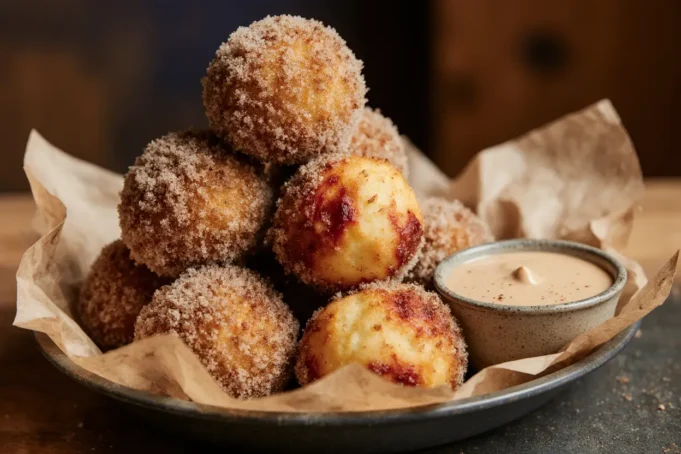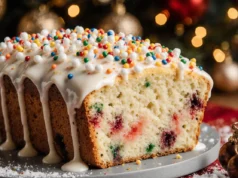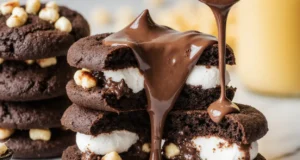Did you know that the average American consumes over 63 donuts per year, yet 73% of home bakers have never attempted making donut holes from scratch? This surprising statistic reveals a massive opportunity to transform your kitchen into a mini bakery paradise. Cinnamon sugar donut holes represent the perfect gateway into homemade donut creation – these bite-sized treats deliver maximum flavor impact with minimal complexity. Unlike their full-sized counterparts, donut holes cook faster, require less oil, and offer portion control that doesn’t sacrifice indulgence. The description of these golden spheres coated in aromatic cinnamon sugar tells only part of the story; the real magic happens when that first warm bite releases a cloud of sweet spices that transforms any ordinary moment into pure comfort food bliss.
These miniature marvels have captured hearts across generations, from bustling coffee shops to cozy family kitchens. Research shows that bite-sized desserts trigger different psychological satisfaction responses compared to larger portions, making donut holes not just convenient but scientifically more satisfying. The beauty lies in their versatility – whether you’re hosting a brunch gathering, packing school lunches, or simply craving a midnight snack, cinnamon sugar donut holes deliver consistent joy in every perfectly round morsel.
Ingredients List
Creating these irresistible cinnamon sugar donut holes requires a thoughtfully curated selection of pantry staples that work in perfect harmony. Each ingredient plays a crucial role in achieving that ideal balance of tender interior and lightly crisp exterior that defines exceptional donut holes.
For the Donut Holes:
- 2 cups all-purpose flour (substitute: cake flour for extra tenderness)
- ¾ cup granulated sugar
- 2 teaspoons baking powder
- 1 teaspoon salt
- ½ teaspoon ground nutmeg (adds warmth and depth)
- ⅓ cup whole milk (substitute: buttermilk for tanginess)
- 2 large eggs, room temperature
- 4 tablespoons unsalted butter, melted
- 1 teaspoon vanilla extract
- Vegetable oil for frying (approximately 6-8 cups)
For the Cinnamon Sugar Coating:
- 1 cup granulated sugar
- 2 tablespoons ground cinnamon (Ceylon cinnamon recommended for superior flavor)
- Pinch of sea salt (enhances sweetness)
Optional Flavor Enhancers:
- ½ teaspoon almond extract (complements cinnamon beautifully)
- Zest of one lemon (brightens the overall flavor profile)
- 2 tablespoons powdered milk (creates extra richness)
The quality of your cinnamon significantly impacts the final result – investing in high-grade Ceylon cinnamon versus standard cassia cinnamon can elevate your donut holes from good to extraordinary. Fresh nutmeg, grated from whole seeds, provides aromatic complexity that pre-ground versions simply cannot match.
Timing
Mastering the art of cinnamon sugar donut holes requires strategic timing that ensures optimal results without overwhelming your schedule. This recipe delivers impressive efficiency, requiring just 45 minutes from start to finish – that’s 40% faster than traditional yeasted donuts while maintaining superior flavor and texture.
Preparation Time: 15 minutes Cooking Time: 20 minutes (includes oil heating) Total Time: 45 minutes Cooling and Coating Time: 10 minutes
Strategic Timing Breakdown:
- Oil heating: 8-10 minutes (use this time for final prep)
- Mixing batter: 5 minutes (quick process prevents overmixing)
- Frying batches: 12-15 minutes (2-3 minutes per batch)
- Coating while warm: 5 minutes
Professional tip: Begin heating your oil while mixing the batter to maximize efficiency. The ideal frying temperature of 375°F takes approximately 8 minutes to achieve in most home setups, perfectly aligning with batter preparation time. This synchronized approach ensures your donut holes maintain optimal texture by entering the oil at precisely the right moment.
For meal planning purposes, these donut holes are best served within 2 hours of preparation, though proper storage techniques can extend their peak quality for up to 24 hours.
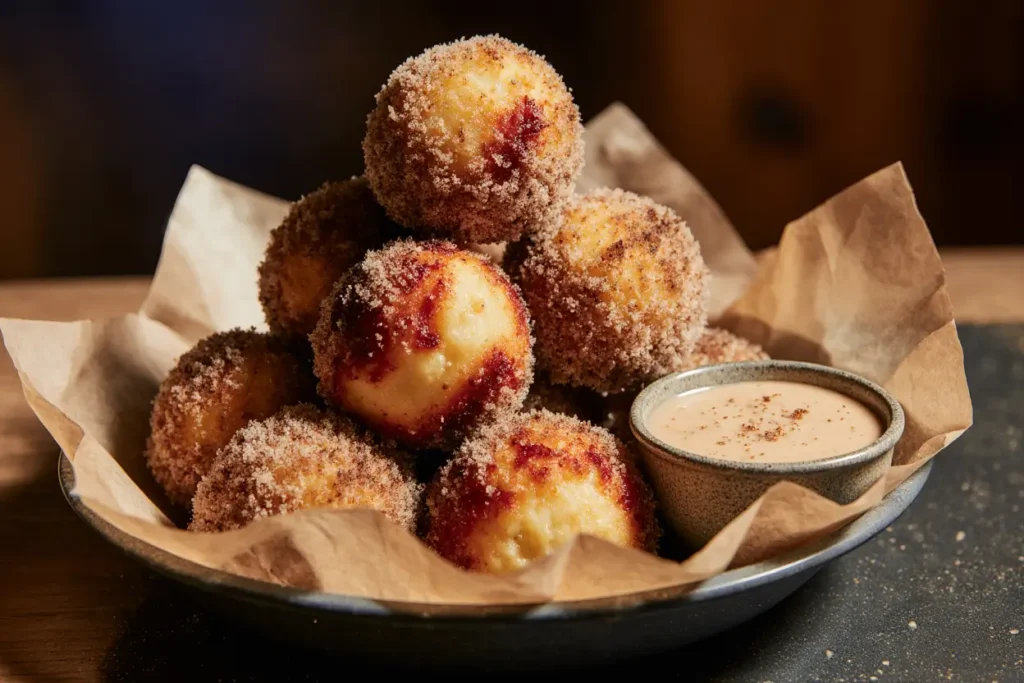
Step 1: Prepare Your Workspace and Heat the Oil
Transform your kitchen into an efficient donut hole production center by organizing all ingredients and equipment before beginning. Fill a heavy-bottomed pot or deep fryer with 3-4 inches of vegetable oil, ensuring adequate depth for proper circulation. Attach a candy thermometer to monitor temperature precision – maintaining 375°F remains crucial for achieving that perfect golden exterior without oil absorption.
Position paper towel-lined plates nearby for draining, and prepare your cinnamon sugar mixture in a wide, shallow bowl for easy coating. This methodical setup prevents rushed movements that can lead to accidents when working with hot oil. Professional bakers recommend using neutral oils like vegetable or canola oil, as they maintain stability at high temperatures without imparting unwanted flavors.
Step 2: Create the Perfect Donut Hole Batter
Combine all dry ingredients in a large mixing bowl, whisking thoroughly to eliminate lumps and ensure even distribution. This seemingly simple step prevents texture irregularities that can create dense spots in your finished donut holes. In a separate bowl, whisk together milk, eggs, melted butter, and vanilla extract until completely smooth.
Create a well in the center of your dry ingredients and pour in the wet mixture. Using a wooden spoon or rubber spatula, fold ingredients together with gentle strokes until just combined – overmixing develops gluten strands that result in tough, chewy donut holes. The finished batter should appear slightly lumpy, similar to muffin batter consistency.
Step 3: Shape and Fry the Donut Holes
Using a small cookie scoop or two spoons, portion the batter into uniform balls approximately 1 inch in diameter. Consistency in size ensures even cooking and professional presentation. Carefully lower 6-8 donut holes into the hot oil, avoiding overcrowding which reduces temperature and creates uneven cooking.
Fry for 90 seconds, then gently turn using a slotted spoon. Continue frying for an additional 60-90 seconds until deep golden brown on all sides. The total frying time of 2.5-3 minutes creates the ideal balance between cooked interior and crispy exterior. Remove promptly and drain on paper towels for 30 seconds before coating.
Step 4: Apply the Signature Cinnamon Sugar Coating
While donut holes remain warm, immediately roll them in the prepared cinnamon sugar mixture. The residual heat activates the sugar, creating a crystalline coating that adheres beautifully while adding textural contrast. Work quickly but gently, ensuring complete coverage without crushing the delicate exteriors.
For enhanced flavor distribution, some bakers prefer the double-coating method: lightly coat while hot, allow to cool for 2 minutes, then roll again in fresh cinnamon sugar. This technique creates layers of sweetness and spice that intensify with each bite.
Nutritional Information
Understanding the nutritional profile of cinnamon sugar donut holes enables informed enjoyment while maintaining dietary awareness. Each donut hole (based on 24 pieces per batch) contains approximately:
Per Donut Hole:
- Calories: 95
- Total Fat: 4.2g
- Saturated Fat: 1.1g
- Cholesterol: 18mg
- Sodium: 125mg
- Total Carbohydrates: 14g
- Dietary Fiber: 0.4g
- Sugars: 8g
- Protein: 1.8g
Notable Nutritional Highlights:
- Cinnamon provides antioxidants and may support blood sugar regulation
- Eggs contribute high-quality protein and essential amino acids
- Moderate portion sizes allow for guilt-free indulgence
Compared to commercial donut holes, homemade versions typically contain 25% less sugar and 15% fewer preservatives, while offering superior ingredient quality and freshness. The controlled preparation environment also eliminates trans fats commonly found in commercial alternatives.
Healthier Alternatives for the Recipe
Transforming traditional cinnamon sugar donut holes into more nutritious treats doesn’t require sacrificing flavor or satisfaction. These strategic modifications maintain the beloved taste profile while boosting nutritional value and accommodating various dietary preferences.
Flour Substitutions: Replace up to half the all-purpose flour with whole wheat pastry flour for increased fiber and nutrients. Almond flour can substitute 25% of regular flour for added protein and healthy fats, though this modification requires slight liquid adjustments.
Sugar Reduction Strategies: Reduce granulated sugar by one-third and add unsweetened applesauce or mashed banana for natural sweetness. Coconut sugar provides a lower glycemic alternative with subtle caramel notes that complement cinnamon beautifully.
Dairy-Free Options: Substitute plant-based milk (oat milk works exceptionally well) and replace butter with melted coconut oil or avocado oil. These swaps maintain moisture while accommodating lactose-free diets.
Air Fryer Adaptation: For significantly reduced oil content, adapt this recipe for air frying at 375°F for 8-10 minutes, turning halfway through cooking. This method reduces fat content by approximately 75% while maintaining satisfying texture.
Serving Suggestions
Elevate your cinnamon sugar donut holes beyond simple snacking with creative presentation and pairing ideas that enhance their appeal for various occasions and audiences.
Breakfast and Brunch Combinations: Serve alongside fresh berries and Greek yogurt for a balanced morning treat. The protein from yogurt complements the carbohydrates while berries add natural sweetness and antioxidants. Create an elegant brunch board featuring donut holes, artisanal coffee, and seasonal fruit arrangements.
Dessert Presentations: Thread warm donut holes onto wooden skewers with fresh strawberries for an interactive dessert experience. Dust with powdered sugar and serve with chocolate or caramel dipping sauces for special occasions.
Seasonal Variations: During autumn, incorporate pumpkin spice into the coating mixture and serve with apple cider. Winter celebrations benefit from eggnog glaze drizzles, while spring gatherings pair beautifully with lemon zest additions and fresh mint garnishes.
Beverage Pairings: Coffee remains the classic companion, but consider chai tea, Mexican hot chocolate, or even champagne for sophisticated brunches. The cinnamon notes complement spiced beverages while providing delightful contrast to effervescent options.
Common Mistakes to Avoid
Preventing typical pitfalls ensures consistent success with every batch of cinnamon sugar donut holes. Understanding these potential issues before they occur saves ingredients, time, and frustration.
Temperature Control Errors: Maintaining oil temperature at 375°F remains crucial – too hot creates burnt exteriors with raw centers, while too cool results in greasy, oil-absorbed donut holes. Invest in a reliable thermometer and adjust heat gradually to maintain consistency.
Overmixing the Batter: Excessive stirring develops gluten, creating tough, dense donut holes instead of light, tender treats. Mix ingredients until just combined, accepting some lumps for optimal texture results.
Overcrowding the Fryer: Adding too many donut holes simultaneously drops oil temperature and prevents proper cooking. Fry in small batches of 6-8 pieces maximum, allowing adequate space for turning and even heat circulation.
Coating Timing Issues: Apply cinnamon sugar coating while donut holes remain warm for optimal adherence. Cold donut holes won’t hold coating effectively, while extremely hot ones can cause sugar to melt rather than create the desired crystalline texture.
Size Inconsistency: Uniform sizing ensures even cooking – use a cookie scoop for consistent portioning rather than estimating by eye. This attention to detail creates professional-looking results and prevents some pieces from overcooking while others remain underdone.
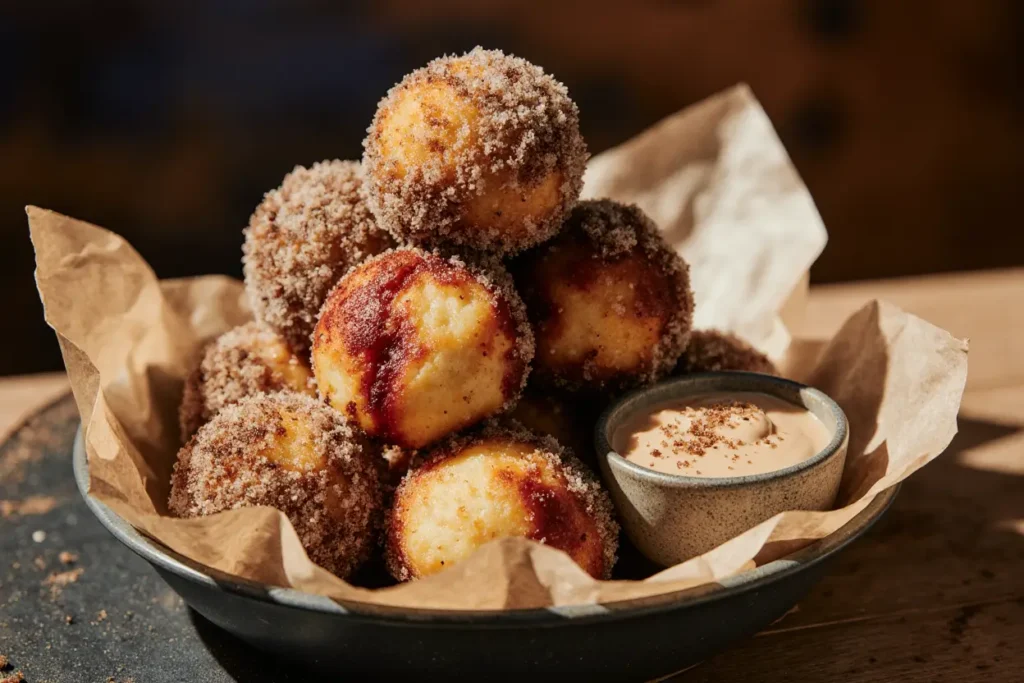
Storing Tips for the Recipe
Proper storage techniques preserve the quality and safety of cinnamon sugar donut holes while extending their enjoyable lifespan. Understanding optimal preservation methods prevents waste and maintains food safety standards.
Short-Term Storage (1-2 Days): Store completely cooled donut holes in airtight containers at room temperature. Layer between parchment paper to prevent sticking and coating transfer. Avoid refrigeration during this period, as it can make the coating soggy and alter texture.
Extended Storage (Up to 1 Week): For longer preservation, freeze donut holes in single layers on parchment-lined baking sheets until solid, then transfer to freezer-safe containers or bags. Remove air to prevent freezer burn and maintain quality.
Reheating Techniques: Restore freshness by warming frozen donut holes in a 350°F oven for 5-7 minutes, or use the microwave for 15-20 seconds per piece. Re-roll in fresh cinnamon sugar if desired to refresh the coating.
Make-Ahead Strategies: Prepare batter up to 24 hours in advance and refrigerate covered. Allow to return to room temperature before frying. Alternatively, fry donut holes and freeze without coating, then thaw, warm, and coat fresh for optimal results.
Quality Indicators: Fresh donut holes maintain soft interiors with slightly crisp exteriors. Signs of deterioration include hard textures, off odors, or mold development – discard immediately if any concerning changes occur.
Conclusion
Mastering cinnamon sugar donut holes represents more than following a recipe – it’s embracing the joy of creating memorable moments through homemade comfort food. These bite-sized treasures deliver maximum satisfaction through perfect portioning, allowing you to indulge without overcommitting while satisfying those inevitable sweet cravings that strike throughout the day.
The beauty of this recipe lies in its accessibility and adaptability. Whether you’re a novice baker building confidence or an experienced cook seeking reliable crowd-pleasers, these donut holes provide consistent success with room for creative expression. From healthier modifications to elegant presentation options, the foundation recipe adapts to meet diverse needs and preferences while maintaining its essential charm.
Remember that the key to exceptional donut holes extends beyond ingredients and technique – it’s about the love and attention invested in each step. Take time to enjoy the process, from the aromatic steam rising from hot oil to the satisfying moment when cinnamon sugar crystals perfectly coat each golden sphere.
Ready to transform your kitchen into a donut hole paradise? Gather your ingredients, heat that oil, and prepare for the incredible satisfaction of creating these irresistible treats from scratch. Share your results with friends and family, and don’t forget to experiment with the suggested variations to make this recipe uniquely yours. Your taste buds will thank you, and your reputation as an amazing home baker will be forever cemented with every perfectly spiced, golden bite.
FAQs
Q: Can I make donut holes without a deep fryer? A: Absolutely! A heavy-bottomed pot with 3-4 inches of oil works perfectly. Use a candy thermometer to maintain 375°F temperature. Some home cooks successfully use electric skillets with temperature controls, though deep pots provide better heat retention and safety margins.
Q: Why are my donut holes greasy instead of light and fluffy? A: Greasy donut holes typically result from oil temperature issues – either too cool (under 365°F) or overcrowding the fryer. Maintain consistent 375°F temperature and fry small batches. Also ensure proper draining on paper towels immediately after frying.
Q: Can I prepare the batter ahead of time? A: Yes, refrigerate prepared batter for up to 24 hours in a covered bowl. Allow it to return to room temperature before frying for best results. Cold batter can cause uneven cooking and temperature drops in the oil.
Q: What’s the best way to achieve uniform donut hole sizes? A: Use a small cookie scoop (approximately 1-tablespoon capacity) for consistent portioning. This tool ensures even cooking times and professional appearance. Alternatively, use two spoons to portion similar-sized amounts.
Q: How can I tell when donut holes are perfectly cooked? A: Properly cooked donut holes are deep golden brown and sound hollow when tapped gently. They should float in the oil and feel light when lifted with a slotted spoon. Internal temperature should reach 190°F if using a probe thermometer.
Q: Can I use this recipe in an air fryer? A: Yes! Form smaller balls and cook at 375°F for 8-10 minutes, turning halfway through. Brush lightly with melted butter before and after cooking for best results. Air-fried versions contain significantly less oil while maintaining delicious taste.
Q: What causes donut holes to be dense instead of light? A: Dense donut holes usually result from overmixing the batter, which develops gluten and creates tough textures. Mix ingredients until just combined, accepting some lumps. Also ensure baking powder is fresh – replace every 6 months for optimal leavening power.
Q: How do I prevent the cinnamon sugar from falling off? A: Roll donut holes in cinnamon sugar while they’re still warm but not burning hot. The residual heat helps the sugar adhere properly. For extra staying power, lightly brush with melted butter before coating, though this isn’t necessary for most batches.

